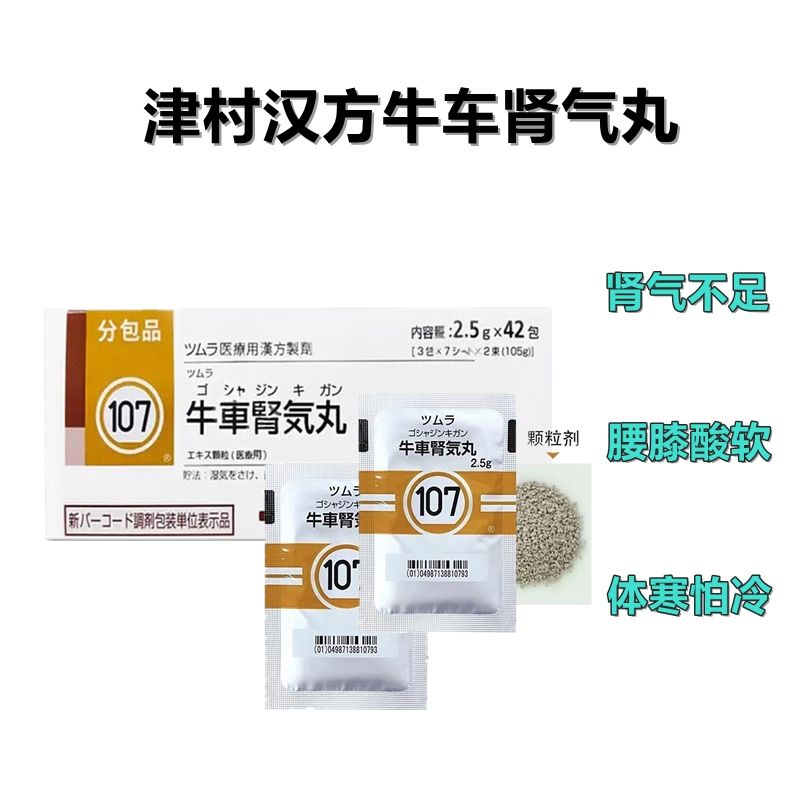
Tsumura Goshajinkigan Extract Granules 2.5g (No. 107): 42 packets (14-day supply)
Today, let’s talk about a traditional Kampo medicine that is highly recognized among the elderly population in Japan—Goshajinkigan (牛車腎気丸, ごしゃじんきがん).
In China, it might not enjoy the same level of popularity as some “trendy” Japanese medicines, but in Japan—especially when it comes to addressing age-related physical discomforts—it plays a very important role. Some even affectionately call it the “guardian of the lower back and knees for seniors,” believing it can help improve unsteady gait and weakness in the legs and back.
So, what exactly is Goshajinkigan? What role does it play within the Japanese medical system? And is it really as “miraculous” as some people say? Today, let’s dive deeper into this Kampo medicine, which embodies the wisdom of Japanese traditional medicine.
Goshajinkigan: The Kampo Medicine Derived from Traditional Chinese Medicine
Goshajinkigan is not a product of modern pharmaceutical development; rather, it originates from a classical formula in traditional Chinese medicine, carrying a rich history.
Its base formula is the renowned kidney-nourishing remedy Hachimi Jio Gan, and Goshajinkigan is made by adding two additional herbs—Achyranthes Root (Goshitsu) and Plantago Seed (Shazenshi)—to it. (This is also the origin of its Japanese name, “Goshajinkigan.”)
Hachimi Jio Gan: Primarily functions to tonify the kidneys and warm yang, often used to alleviate symptoms caused by kidney yang deficiency, such as fatigue, lower back and knee weakness, aversion to cold, cold extremities, and abnormal urination.
Achyranthes Root (Goshitsu): In traditional Chinese medicine, it is believed to promote blood circulation, tonify the liver and kidneys, strengthen tendons and bones, promote urination, and guide blood downward.
Plantago Seed (Shazenshi): Has diuretic effects, clears heat, benefits the eyes, and helps resolve phlegm and stop coughing.
In Japan, Kampo medicine is officially integrated into the national health insurance system, with its own unique diagnostic and treatment model. As one of the most widely used Kampo prescriptions, Goshajinkigan is commonly prescribed in clinical practice—especially to address symptoms like lower back and knee weakness, frequent urination, and lower limb fatigue in elderly patients—earning the trust of both doctors and patients alike.
Why Is It Called the "Guardian of the Lower Back and Knees" for Seniors?
Why is Goshajinkigan often referred to as the “guardian of the lower back and knees” for seniors, and why is there a saying in Japan that it helps with walking stability? This is closely related to the “efficacy and indications” officially approved by the Japanese Ministry of Health, Labour and Welfare (similar to China’s National Medical Products Administration).
According to official information from the Pharmaceuticals and Medical Devices Agency (PMDA) and the Ministry of Health, Labour and Welfare, Goshajinkigan is mainly indicated for the following symptoms:
✅ Mild to moderate physical weakness, easy fatigue, cold hands and feet
✅ Decreased or excessive urination, sometimes accompanied by thirst
✅ Specific approved indications:
Lower limb pain, lower back pain, numbness
Blurred vision in the elderly
Itching
Urination difficulties, frequent urination
Swelling (edema)
As we can see, these symptoms directly include “lower limb pain,” “lower back pain,” and “numbness”—which are common causes of unsteady gait and walking difficulties in the elderly. When patients present with symptoms that match Goshajinkigan’s Kampo Pattern (typically kidney yang deficiency with water retention or blood stasis), Japanese doctors and pharmacists often consider prescribing it to improve these issues.
In recent years, modern medical research has also explored the potential of Goshajinkigan, investigating its effects on diabetic neuropathy-related pain and numbness, chemotherapy-induced peripheral neuropathy, and urinary problems in the elderly. While these studies offer new insights into its potential benefits, it’s important to note that many conclusions come from small clinical trials or animal studies, and further research is needed to confirm their findings. Therefore, Goshajinkigan should always be used under the guidance of a qualified physician or pharmacist and should not be relied upon blindly or used as a substitute for standard treatments.
In conclusion, the connection between Goshajinkigan and the health of the “lower back and knees” is rooted both in its officially approved indications in Japan and in its traditional Kampo theory of “tonifying the kidneys and strengthening the lower back.” For patients experiencing relevant symptoms, it is indeed a treatment option that doctors may consider—but it is important to approach its use scientifically and rationally.
